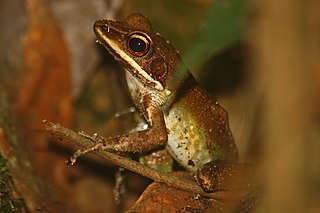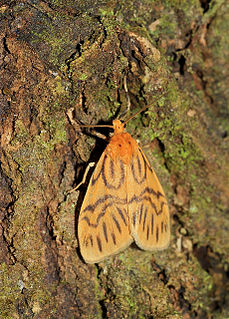
Schizostachyum is a tall or shrub-like tropical genus of bamboo. They are natives mostly of tropical Asia and Papuasia, with a few species in Madagascar and on certain islands in the Pacific. A few have become naturalized in other tropical regions.

Coelognathus radiatus, commonly known as the Radiated Ratsnake, Copperhead Rat Snake, or Copper-headed Trinket Snake, is a nonvenomous species of colubrid snake.

Amnirana is a genus of frogs in the family Ranidae, "true frogs". The genus is primarily found in Sub-Saharan Africa, but one species occurs in parts of southern and southeastern Asia. Some of the African species are widespread but contain undescribed cryptic diversity. Most species have a white upper lip, and the genus is sometimes known as the white-lipped frogs.

Fejervarya limnocharis is a species of frog found in South East Asia and parts of Indochina. It is known under many common names, including Boie's wart frog, rice field frog, and Asian grass frog. Molecular studies of the species complex suggest that there may be multiple species involved.

The crab-eating frog is a frog native to south-eastern Asia including Taiwan, China, the Philippines and more rarely as far west as Orissa in India. It has also been introduced to Guam, and was most likely introduced from Taiwan. It inhabits mangrove swamps and marshes and is one of only 144 known modern amphibians which can tolerate brief excursions into seawater.

Ingerophrynus parvus is a species of toad in the family Bufonidae. It is found in southern Myanmar, southwestern Thailand, southwestern Cambodia, Peninsular Malaysia, and Java and Sumatra (Indonesia). Its natural habitats are primary and regenerating rainforests where it is found inhabiting streams. Breeding takes place in pools and slow-moving streams. It is common in the mainland but uncommon in Indonesia.

The palmated chorus frog is a species of frog in the family Microhylidae. It is found in Indonesia and Malaysia. Its natural habitats are subtropical or tropical moist lowland forests, rivers, and freshwater marshes. It is not considered threatened by the IUCN.
The Malesian frog, Malaysian river frog, Malaysian peat frog, or peat swamp frog is a species of frog in the family Dicroglossidae. It is found on the Malay Peninsula, Sumatra, Java, Borneo, and a range of islands on the Sunda Shelf . Its natural habitats are shallow, gentle streams and nearby swampy areas including peat swamps, very flat alluvial forests, and overgrown plantations. It is becoming rare due to habitat loss (deforestation), and to a lesser extent, exploitation.

The common green frog is a frog species of in the true frog family Ranidae; some sources still use the old name Rana erythraea. It lives in Southeast Asia and is also known as green paddy frog, red-eared frog or leaf frog. The last name, however, commonly refers to the Neotropical tree frogs which make up the subfamily Phyllomedusinae. These are not closely related to H. erythraea, belonging to family Hylidae instead.
Djoko Tjahjono Iskandar is an Indonesian herpetologist who studies the amphibians of Southeast Asia and Australasia. He is a professor of biosystematics and ecology at Bandung Institute of Technology in West Java, Indonesia.

Pulchrana baramica, the Baram River frog, brown marsh frog, or masked rough-sided frog, is a species of "true frog", family Ranidae. It is found in the Malay Peninsula, including the extreme south Thailand, Peninsular Malaysia, and Singapore, and in the Malay Archipelago, including Borneo, and the Indonesian islands Java, Sumatra, and Bangka Island. Its type locality is the Baram River in Sarawak, Malaysia, giving it one of its common names. Its natural habitats are tropical moist lowland forests and swamps. It is not considered threatened by the IUCN.

Hylarana macrodactyla is a species of frog in the family Ranidae. It is also known as the Guangdong frog, three-striped grass frog and the marbled slender frog.

Abavorana luctuosa, also known as the Malaysian frog, mahogany frog or purple frog, is a species of true frog. It is found in the Malay Peninsula and in Borneo. It was formerly placed in the genus Hylarana.

Tridrepana albonotata is a moth of the family Drepanidae described by Frederic Moore in 1879. It is found in India, Nepal, Vietnam, Sri Lanka, Peninsular Malaysia, Sumatra, Borneo, Java, Bali and Sulawesi.

Hylarana glandulosa, commonly known as the rough-sided frog or the glandular frog, is a species of true frog in the genus Hylarana. It is native to Brunei Darussalam, Indonesia, Malaysia, Singapore, Thailand, and Vietnam. Its natural habitats are subtropical or tropical moist lowland forest, subtropical or tropical swampland, rivers, freshwater marshes, caves, and plantations. It is not considered threatened by the IUCN.

Asura fulguritis is a lichen moth of the family Erebidae, subfamily Arctiinae. The species was first described by George Hampson in 1900. It is found on Bali, Java, Sumatra, Pulo Laut, Borneo and Peninsular Malaysia. The habitat consists of lowland and lower montane forests.
Pulchrana centropeninsularis is a species of "true frog", family Ranidae. It is found in Peninsular Malaysia and Sumatra (Indonesia). The specific name centropeninsularis refers to the area of its original discovery, the state of Pahang in the central Peninsular Malaysia. Later on, it has also been recorded in the province of Jambi in east-central Sumatra. Pulchrana centropeninsularis is a rare species known from few individuals only. Prior to its description, Pulchrana centropeninsularis was confused with Pulchrana siberu, its closest relative.















